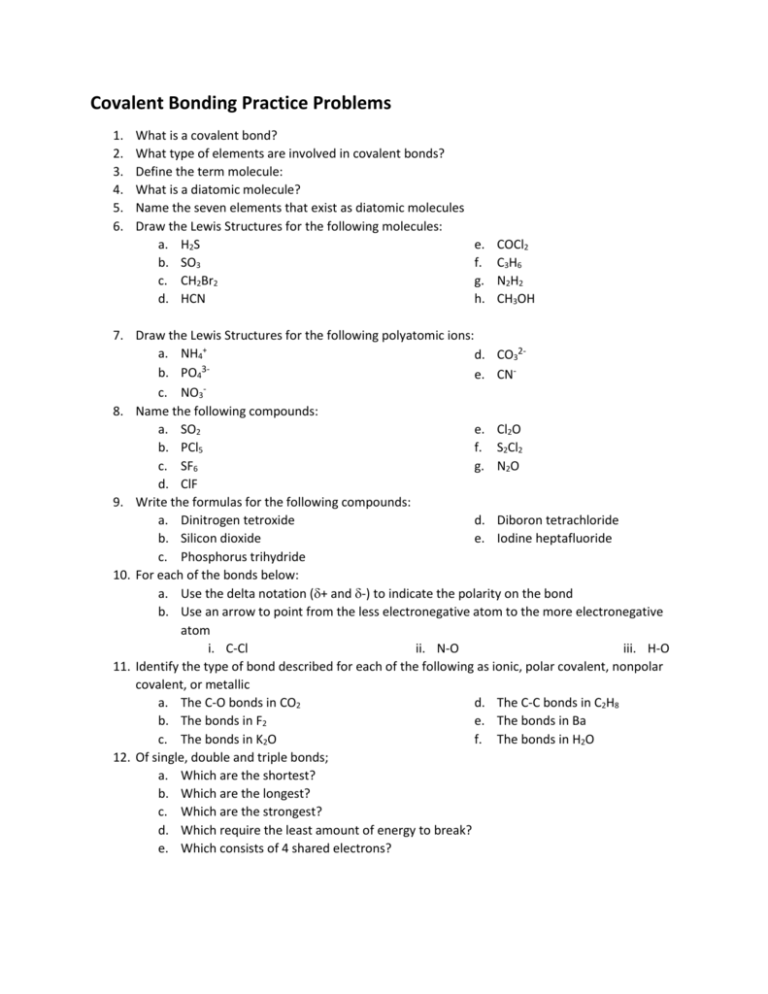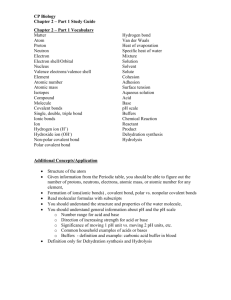Extra Practice: Covalent Bonding w/ Key
advertisement

Covalent Bonding Practice Problems 1. 2. 3. 4. 5. 6. What is a covalent bond? What type of elements are involved in covalent bonds? Define the term molecule: What is a diatomic molecule? Name the seven elements that exist as diatomic molecules Draw the Lewis Structures for the following molecules: a. H2S b. SO3 c. CH2Br2 d. HCN e. f. g. h. COCl2 C3H6 N2H2 CH3OH 7. Draw the Lewis Structures for the following polyatomic ions: a. NH4+ d. CO32b. PO43e. CNc. NO38. Name the following compounds: a. SO2 e. Cl2O b. PCl5 f. S2Cl2 c. SF6 g. N2O d. ClF 9. Write the formulas for the following compounds: a. Dinitrogen tetroxide d. Diboron tetrachloride b. Silicon dioxide e. Iodine heptafluoride c. Phosphorus trihydride 10. For each of the bonds below: a. Use the delta notation (+ and -) to indicate the polarity on the bond b. Use an arrow to point from the less electronegative atom to the more electronegative atom i. C-Cl ii. N-O iii. H-O 11. Identify the type of bond described for each of the following as ionic, polar covalent, nonpolar covalent, or metallic a. The C-O bonds in CO2 d. The C-C bonds in C2H8 b. The bonds in F2 e. The bonds in Ba c. The bonds in K2O f. The bonds in H2O 12. Of single, double and triple bonds; a. Which are the shortest? b. Which are the longest? c. Which are the strongest? d. Which require the least amount of energy to break? e. Which consists of 4 shared electrons? Covalent Bonding Practice Problems KEY 1. What is a covalent bond? A bond formed by the sharing of one or more pairs of electrons between two atoms 2. What type of elements are involved in covalent bonds? Nonmetals 3. Define the term molecule: A single unit of a covalently bonded compound 4. What is a diatomic molecule? A covalent bond between two of the same type of atoms 5. Name the seven elements that exist as diatomic molecules H2, N2, O2, F2, Cl2, Br2, I2 6. Draw the Lewis Structures for the following molecules: a. H2S e. COCl2 b. SO3 f. c. CH2Br2 C3H6 g. N2H2 h. CH3OH d. HCN 7. Draw the Lewis Structures for the following polyatomic ions: c. NO3a. NH4+ d. CO32b. PO43e. CN8. Name the following compounds: a. SO2 Sulfur dioxide b. PCl5 Phosphorus pentachloride c. SF6 Sulfur hexafluoride d. ClF Chlorine monofluoride e. Cl2O Dichlorine monoxide f. S2Cl2 Disulfur dichloride g. N2O Dinitrogen monoxide 9. Write the formulas for the following compounds: a. Dinitrogen tetroxide N2O4 d. Diboron tetrachloride B2Cl4 b. Silicon dioxide SiO2 e. Iodine heptafluoride IF7 c. Phosphorus trihydride PH3 10. For each of the bonds below: a. Use the delta notation (+ and -) to indicate the polarity on the bond b. Use an arrow to point from the less electronegative atom to the more electronegative atom i. C-Cl ii. N-O iii. H-O 11. Identify the type of bond described for each of the following as ionic, polar covalent, nonpolar covalent, or metallic a. The C-O bonds in CO2 Polar Covalent b. The bonds in F2 Nonpolar Covalent c. The bonds in K2O Ionic d. The C-C bonds in C2H8 Nonpolar Covalent e. The bonds in Ba Metallic f. The bonds in H2O Polar Covalent 12. Of single, double and triple bonds; a. Which are the shortest? Triple b. Which are the longest? Single c. Which are the strongest? Triple d. Which require the least amount of energy to break? Single e. Which consists of 4 shared electrons? Double






